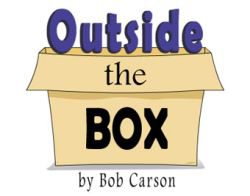Roaring Lions
February 18, 2019,Editor’s Note: The USTA website is pleased to present freelance writer Bob Carson and his popular “Outside the Box” features. This monthly series is a menu of outlandish proposals presented with a wink — but the purpose behind them is serious. The views contained in this column are that of the author alone, and do not necessarily represent the opinions or views of the United States Trotting Association.
The future of commerce is complex.
People spend more time online spending their money. This trend will continue. The value of brick-and-mortar businesses is under assault. It does not matter if your business is in retail, in service, or in sports. It is clear that the future will be different from the past and much of it will be in the cloud. If physical retailers are to have a future, they will need to offer a radically improved customer experience.
Somewhere in this mix is horse racing. What is the best course for brick-and-mortar racetracks?
 Basic geography has been, and always will be, a hugely limiting factor. The percentage of gamblers who can easily drive to a racetrack is minuscule. This logistical limitation complicates the question of how racetracks should spend time, effort, and treasure. Is the smart money on attendance and presentation at your local facility, or should the digital presentation get the lion’s share of attention?
Basic geography has been, and always will be, a hugely limiting factor. The percentage of gamblers who can easily drive to a racetrack is minuscule. This logistical limitation complicates the question of how racetracks should spend time, effort, and treasure. Is the smart money on attendance and presentation at your local facility, or should the digital presentation get the lion’s share of attention?
One size does not fit all.
A glimpse of our harness racetracks shows a different picture for each. Some, like The Meadowlands, have the population density and motivation that makes on-track attendance promising. Other racetracks find that live attendance is not cost effective and they may turn to an all-digital presentation of their races.
The Amazon effect is here, it is real, and it will affect racing. In order to remain competitive in the digital age, the physical facilities we are familiar with will need to be different and will need to offer something online stores cannot.
In horse racing, we have advantages over a shoe store or a hardware store. We have the horse and the people involved in a horse race. They offer us a leg up on the digital experience. We can offer the opportunity to meet our product. We can offer this more easily than other sports. This human/horse connection for customers in racing is not a new concept, but it is a new world.
Imagine you make the effort to take your wife, friends, or children to see our sport. You want them to see a horse, touch a horse, smell a horse, and hear a horse. You want them to watch people work with horses, dress them, walk them, and brush them before and after races. You want your visitors to interact with the workers who explain what and why they are doing what they do.
Here is what you do not want. You do not want to take visitors to a seat in the grandstand where they sit and watch six minutes of racing in one hour. Racing is different from a ballgame. We are quick, sporadic, and often confusing bursts of action. In 2019, audiences will not stand (sit) for this.
The racetrack experience for old and new visitors should be strolling and mingling rather than sitting. The experience should be active, not passive. What if a racetrack retooled and made the premises resemble a visit to a modern zoo? What if visitors not only could see the horses, but they would see them cared for, prepared and then actually do something — race for money?
Some will say, “We tried that at Toledo Raceway in 1962; we had a glass wall where people could watch the paddock. It wasn’t the answer.”
The world has changed, racing has changed, and zoos have changed.
Modern zoos are often cage-free nature parks. They emphasize the well-being of the animals while attracting visitors who don’t enjoy the old-fashioned type of zoo where animals were in cages. Modern zoos push the envelope by making visitors feel as if they are going on a safari. They transport visitors through animal habitats. They explain ecosystems and species development. To bolster the premise that horse racetracks should have some zoo-like aspects, attendance at zoos is on the rise in a digital age.
It cannot be impossible to make adjustments to allow more interaction with our horses and people. Fenced walkways would offer safety. Having people watch a groom buckle a harness on a filly in cross-ties should be very doable. This would be fun and educational for visitors and a tonic for most grooms and trainers.
By integrating the harness racing backstretch and customers, a visit to a racetrack could be a place where visitors learn. Workers would take pride in what they do and become ambassadors for the sport. The horse, our best asset, should have full rein to do what they do best — impress with their power, grace and beauty.
Some will say, “Racing is not a zoo, it is a gambling business.”
This is true, but the racetrack of the future, both on and off the premises, must evolve and we cannot disregard the Amazon effect. Racetracks can and should emulate the aspects that make Amazon the largest retailer in the world.
Brick-and-mortar racetracks must offer a frictionless, near-immediate sale (gamble). Gambling kiosks and hand-held devices should replace wagering windows. The wager on a horse race must become ridiculously simple (and hopefully more valuable).
A racetrack has a large footprint. Once the doors to both the front and the back are open and welcoming, other peripheral activities are possible. Leveraging the equine facility is possible. Other retailers and entrepreneurs can throw events ranging from happy hours to workshops and concerts. The repurposed facility could attract new customers and establish the premises as an asset to the community.
Racetracks, like most brick-and-mortar businesses, are struggling. To generate more traffic, they should consider any successful ideas that attract in-person visitors.
Just look at zoos.

